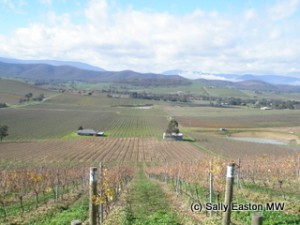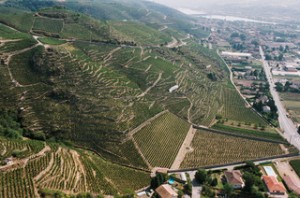Syrah/shiraz from around the world – a blind tasting
Every few months I organise a themed tasting seminar for a group of local business people. We taste blind and discuss the wines.
In some countries, syrah/shiraz is very new on the global stage. France and Australia have long-established syrah/shiraz vineyards. Indeed shiraz in Australia accounts for just under 50% of that country’s red vineyard area. But it is in Chile and South Africa where plantings have exploded at a triffid-like rate. In South Africa the syrah/shiraz vineyard has just about doubled in a decade to reach 10% share of the total vineyard, and in Chile, a decade’s growth has seen syrah/shiraz acreage increase from 200 hectares (ha) to over 3,500 ha. Some Californians are predicting syrah/shiraz to be their next ‘new thing’.

De Bortoli, Yarra Valley
Issues on the global syrah/shiraz agenda included labelling in the new world as a style differentiator. As in, if the producer thinks his/her shiraz is more French in style, label it syrah. This could also follow the cooler fruit (syrah) / warmer fruit (shiraz) paradigm, but the anecdotal reality of just this tasting suggests any labelling protocol so far exists only the minds of some producers. The Craggy Range and the De Bortoli might fit the mould, but the South African pair might have been labelled the other way round. Torbreck avoids the issue completely by using leaving off the varietal from the front label.
We discussed the use of a tiny (<5%) proportion of viognier (skins, lees, wine, pressings) in the shiraz ferment, which can lift perfume, soften tannin, stabilise colour. See here for a (slightly) deeper view.
American versus French oak is usually the other theme that arises with shiraz/syrah, but the group seemed more concerned with too much unintegrated oak, regardless of origin, on one or two of the wines.
Summary of group comments
Rated by the group, wines with high approval quotient, for differing reasons, in alphabetical order:
- Grant Burge Meshach Shiraz 2004, Barossa, Australia, £48.99. Fareham Wine Cellar
- Craggy Range Le Sol Syrah 2007, Gimblett Gravels, Hawke’s Bay, New Zealand, £34.95. New Zealand House of Wine
- De Bortoli Reserve Release Syrah 2005, Yarra Valley, Australia £19.
- Domaine Michel et Stéphane Ogier Côte-Rôtie 2006, Rhône valley, France 2006, £410.38/doz (£34.20/btl. Armit
- Torbreck Descendant 2006, Barossa Valley, Australia £79.95 / btl or £340/6 in bond, LCB. Handford Wines
All three Aussie wines made it into the top five. The group couldn’t quite believe that both the Burge Meshach and the Torbreck Descendant were from the Barossa Valley, the Meshach completely typical in the classic mould; the Torbreck silky smooth and aromatic (my words). The De Bortoli, from the Yarra Valley, was completely different again.

Côte-Rôtie
Some suggested the old world for the De Bortoli, as indeed did some for the Craggy Range. I suspect both producers will be happy with that.
The Côte-Rôtie was a lesson in class.
The feedback on the Chilean and South African pair was less flattering, price and value for money being a concern. Given some of the prices demanded, no forgiveness was offered for the fact that both Chile and South Africa are really very new to shiraz/syrah. Young vines so often make young wines, it can be difficult to build in layers of complexity with young-vine fruit. Nonetheless the group was least happy with these.
My tasting notes, not blind, March 2010.
General observations
- Alcohol was evident, and therefore not fully in balance, in too many of the wines.
- Although tasting young wines, there was still too much new oak evident one or two of the wines.
- Despite some of the alcohols, a remarkable degree of acid freshness was present in all the wines.
The Foundry Syrah 2004, Coastal Region, South Africa, £16 (14.5%)
Deep ruby colour; floral, red berries. Supple, sweet, enticing palate attack with sweet plum and liquorice-confectionery notes. Full bodied, dry-roasted spices. Slight distraction of burnt charcoal note in the far distance of the palate. Powerful and alcoholic, with the sweetness of red-berried fruit bringing it all back into perspective in a wholesome if not particularly rounded fashion.
Luddite Shiraz 2005, Walker Bay, South Africa, £25 (14%)
Dark translucent ruby colour; cinnamon, sandalwood and cherry blossom spectrum of aromas. Earthy aromatics and freshness of fruit-focused palate to fore, with smoky tar note towards back of palate. Lush, sweet fruit held in frame by restraining fresh acid core. Smooth texture, focus on density and breadth of fruit expression, with some noteworthy elegant elements incorporated within this. Final finish is just caught off guard for an instant with a short note of bitter caramel, which detracts from an otherwise somewhat restrained shiraz within a forceful South African genre.
Amayna Syrah 2007, Leyda Valley, Chile, £20 (14.5%)
Deep inky plum colour. Sweet red plum and heady allspice nose with mocha notes. Crunchy, young attack, with alcohol too evident. Rich fruit intensity counters the heat of alcohol, and the fruit is fresh-picked, (alluding to its windy coastal location? Certainly no baked characters) in the sweet plum, liquorice, black berry and allspice spectrum. Some positive herbal notes. Full bodied with grainy youthful texture.
Montes Folly Syrah, 2006, Apalta, Santa Cruz, Colchagua Valley, Chile, £35 to £40 (15%)
Deep ruby colour with bright translucence to the rim. Red cherry and sandalwood nose, with hints of tobacco. Dark spices, some aromatic tarry notes, a smoothening texture all combine to create a wine layered with ripe fruit and rich toasted, caramel notes. Alcohol comes through quite strongly at the back of the palate. Full-bodied, heady and sweet-textured with tarry, plum, bitter chocolate and notes of fresh leather, more savoury, by design, than fruity, in a youthful expression. Do need to watch the alcohol.
Craggy Range Le Sol Syrah 2007, Gimblett Gravels, Hawke’s Bay, New Zealand, £35 (14%)
Deep ruby with purple hints. A floral hit on the nose is followed by red fruits – raspberries, redcurrants – then fresh leather and green tea. Smooth palate attack of crunchy, youthful fruit, in a medium to full bodied style, made complex by aromatic tar, dark berry fruits in the depth of the palate, and an elegance beyond that suggested by its integrated 14% of alcohol. The alcohol is invisibly seamed into the whole, to create a wine of some significant refinement as well as with plenty of aromatic and fruit power. Really very nice, and very young. Sophistication in development.
De Bortoli Reserve Release Syrah 2005, Yarra Valley, Australia, £20 (14%)
Medium deep ruby colour; aromatic, floral, perfumed. Clearly a different style from its predecessors in the flight, just on colour and nose. Sweet, fresh fruit compote attack, strawberry, raspberry, in a medium-bodied wine of focus and length in the palate. Immediately elegant, with fronds of fruit swaying from a fresh backbone of acid structure. Alcohol is seamless. All the focus is on fruit-freshness equilibrium with acidity, which works wonderfully well. Serious, refined, definitely a cooler style – not any jamminess to the fruit. If you like Barossa shiraz, don’t try this at home.
Gayda Chemin de Moscou 2007, Vin de Pays d’Oc, France, £20 (14%)
This was a slight interloper, having tasted and loved it at a recent trade tasting. Just 72% syrah, with grenache and cinsault. Plenty of strawberry perfume waving from the glass and lingering. Palate attack is soft, voluptuous, dense and intense and this persists through the palate. Medium bodied, with ripe red berry fruits of the forest, alcohol integrated, tannins imperceptibly silky in the sweet-glycerol texture. There’s a hint of garrigue spiciness, aromatic herbal notes, thyme and rosemary that add layers to this complex, modern style of wine. Balanced, intense flavours without dominating power.
Domaine Michel et Stéphane Ogier Côte-Rôtie 2006, Rhône valley, France 2006, £35 (13%)
Medium deep ruby. Violets, raspberries, aromatic tar, a reminiscence of liquorice stick. Sweet-yet-fresh strawberry and raspberry fruit, medium-bodied and perfumed, elegant, refined, with a long, long finish. Restraint, elegance yet depth and intensity of fruit flavour, with silky lightness of seamlessly-grained tannin, yet which are plentiful and framing, for some years yet. The fruit plumbs unchartered depths of the palate profile. It has balance, it has integrity; an inspiring wine.
Château Maris, Old Vine Syrah 2007, Minervois La Livinière, Languedoc, France, £20 (15%)
Medium deep translucent ruby. Has the spicy, herbal garrigue nose of Southern France with sweet red berry fruits emerging from the herbal introduction. Fresh-stewed berry fruits, with sweet cinnamon, allspice and juniper berry. The palate is smooth, the tannins fine-grained. Savoury, biltong and leather notes are developing amid the sweet berries. This is a big winewith some considerable power, and the alcohol is fully integrated, adding to that sweet-mulled note. An epitome of the big-brute softie.
Grant Burge Meshach Shiraz 2004, Barossa, Australia, £50 (14.5%)
Deep ruby colour; minty, sweet-plum and sweet chocolate nose. Soft-fruited palate attack with focus on warm curry spices. The alcohol is held in check well. Gorse and coconut notes of American oak play their integral part. The palate is sweet, lush, full bodied, and slick with a smooth- glycerol texture. Tarry, charcoal aromatics come to the fore at the back of the palate in a wine that shows many layers of lush complexity. Sweet fruit, lush, palate-coating sweet tannins, big, full-fat, full-body, concentrated and brutishly seductive. You wouldn’t want less from the Barossa.
Torbreck Descendant 2006, Barossa Valley, Australia, £75 to £80 (15%)
Possibly the opposite extreme of the Barossa Valley: deep translucent ruby colour. Violet and morello cherry perfume erupts enticingly from the glass. Deeply-fruited wine whose refinement seems evident on the nose, if only such a thing were technically possible. Freshly-sweet fruit, with the acid structure keeping the focus upstanding. Perfumed palate, elegant, toasted, tar notes offering layers of complexity and depth. Lush and sweet, all held in balanced check by that fresh acid core. Fleshy layers of sweet berried fruit, supremely well balanced and layered. Seriously good. It has concentration and density without massive power and guts, and the alcohol is completely unnoticed with all the seductive beauty of the fruit and fine, sweet tannin structure.



